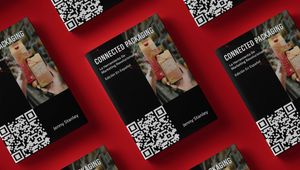
Beyond the Container: Packaging as Your Most Powerful Media Asset

In a world where traditional media channels continue to fragment and lose effectiveness, I've witnessed packaging emerge as perhaps the most reliable direct touchpoint between brands and consumers. That's why I'm particularly excited about the launch of the Interactive Brand Packaging Network (IBPN), a groundbreaking initiative announced by the Active & Intelligent Packaging Industry Association (AIPIA) in March.
As someone deeply invested in the future of brand-consumer interactions, the IBPN is a critical development that will finally establish packaging as a recognised and measurable media channel. This isn't just about adding QR codes - it's about transforming packaging from a passive container into a strategic media asset.
Why brands need the IBPN now more than ever
The timing couldn't be more crucial. Traditional advertising channels are struggling - TV viewership continues to decline, digital spaces are plagued by bots, ad blockers and brand safety issues. Meanwhile, regulatory changes are pushing brands toward connected packaging whether they're ready or not.
Tesco is already trialling GS1 Sunrise implementation across 20% of their products, and the Digital Product Passport, a new regulation for nearly all products sold in the EU to feature, is rapidly approaching mandatory status. Add to these the evolving sustainability regulations like PPWR and EPR that require packaging modifications, and it becomes clear: brands need expert guidance to navigate this shifting landscape.
That's precisely what the IBPN offers - an industry-wide ecosystem and authoritative body that will establish measurement standards, share best practices and develop ROI frameworks that enable brands to effectively utilise packaging as part of their media strategy.
The benchmarking framework: Moving from cost to revenue generation
One of the most exciting developments is the benchmarking framework. This will give brands a clear framework (rather than just finding budget) to understand the ROI of connected packaging initiatives.
What's often overlooked is that connected packaging isn't just a cost centre - it's a potential revenue generator. Consider the brand with a massive counterfeiting problem costing millions annually. Connected packaging that solves this issue instantly justifies its implementation and frees up budget for additional innovations.
Similarly, brands struggling with traceability issues - where product intended for one market mysteriously appears in another - can leverage connected packaging to resolve these million-dollar problems.
The IBPN's benchmarking framework will help brands quantify these benefits, transforming the conversation from ‘can we afford this?’ to ‘can we afford not to do this?’.
The Connected Brand Packaging track at AIPIA & AWA World Congress
For those looking to dive deeper into these opportunities, the Connected Brand Packaging & IBPN track at the upcoming AIPIA & AWA Smart Packaging World Congress on June 23-24, 2025, in Amsterdam will give you the latest insights, trends and knowhow.
I’ll, of course be joining a panel session, on ‘The Future of Connected Packaging: What's Next for Brands?’ panel on 23 June at 3:30pm (CEST). It brings together industry heavyweights from AB InBev, GS1, Tesco,and Coca-Cola to explore the evolving landscape of connected packaging. The not-to-be-missed discussion will focus on upcoming opportunities and challenges in interactive packaging over the next year, highlighting how brands can leverage these innovations to navigate tough market conditions and drive consumer engagement.
The timing is perfect, as these companies are at the forefront of implementing many of the changes we're discussing. Tesco's GS1 Sunrise trial makes them especially valuable contributors to this conversation, while AB InBev and Coca-Cola continue to lead innovative consumer engagement through packaging.
The track, co-led by myself and fellow IBPN organiser Paul Simonet at Experience is Everything, will feature 10 sessions focusing on how brands can leverage IoT-enabled packaging, AI-powered solutions and digital engagement strategies to enhance product interaction, security and traceability.
The value proposition is clear
As brands are already facing the requirement to adapt their packaging to meet new regulations, why not maximise the opportunity? If you're going to add QR codes and other interactive elements to comply with legislation, you might as well gain the marketing advantages: understanding your consumers better, improving inclusivity, enhancing sustainability messaging and creating direct communication channels.
The IBPN provides the expertise to help brands navigate these complex waters, offering informed expertise with practical applications. Rather than piecing together solutions from multiple vendors with potentially conflicting interests, brands can join the IPBN to access a collaborative network focused on establishing industry standards and sharing success stories.
In the media landscape, where connecting meaningfully with consumers grows ever more challenging, packaging remains the one touchpoint brands can control completely. The IBPN is poised to help us all make the most of this powerful but often underutilised asset.
The potential is enormous: 100% viewability with zero wastage - something other digital media channels can only dream of achieving. As traditional and digital media continue to face challenges, connected packaging stands ready to become the next frontier in brand communication.
I look forward to seeing you at the AIPIA & AWA World Congress to learn more, to collectively shape the future of brand packaging as a dynamic media channel.
Jenny Stanley is MD at Appetite Creative, for more information visit: appetitecreative.com
For more information about the AIPIA & AWA World Congress, visit: sustainability-in-packaging.com/mena















